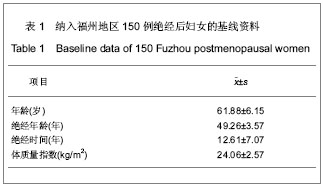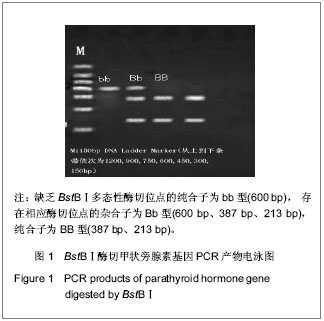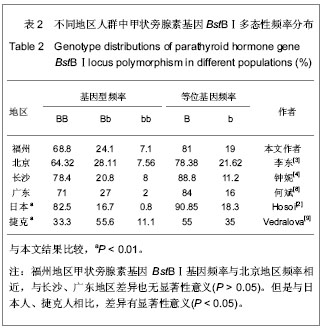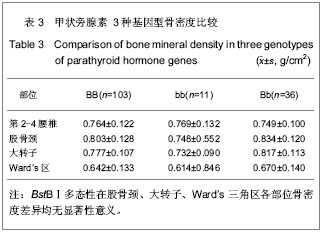| [1] Morrison NA,Qi JC,Tokita A,et al.Prediction of bone density by vitamin D receptor allele.Nature. 1994;367(6460):284-287.[2] Hosoi T,Miyao M,Inoue S,et al. Association study of parathyroid hormone gene polymorphism and bone mineral density in Japanese postmenopausal women.Calcif Tissue Int.1999;64(3):205-208.[3] 李东,董兆文,薛延,等.绝经后健康妇女甲状旁腺激素基因多态性与骨密度的关系[J].遗传,2003,25(2):133-136.[4] 陈正林,潘继承,刘俊恒,等.女性围绝经期骨密度和E2、PTH、CT相关性分析[J].实用老年医学,2009,23(6):470-471.[5] 钟妮,张红,伍贤平,等.甲状旁腺激素基因多态性与女性骨量及骨相关生化指标的关系[J].中华医学杂志,2006,86(6):376-379.[6] 中华人民共和国国务院.医疗机构管理条例.1994-09-01.[7] 刘忠厚,杨定焯,朱汉民,等.中国人骨质疏松症建议诊断标准(第二稿)[J].中国骨质疏松杂志,2000,6(1):1-3.[8] 何斌,李东风,吴文,等.甲状旁腺激素基因多态性对广东地区老年人骨密度的影响[J].实用医学杂志,2011,27(12):2257-2260.[9] Vedralová M, Kotrbova-Kozak A, Zelezníková V,et al. Polymorphisms in the vitamin D receptor gene and parathyroid hormone gene in the development and progression of diabetes mellitus and its chronic complications, diabetic nephropathy and non-diabetic renal disease. Kidney Blood Press Res. 2012;36(1):1-9. [10] 肖益热,刘景晶. 甲状旁腺激素生理作用和构效关系研究[J]. 药学进展,2003,27(4):206-209.[11] 刘言华,凤姣,尤科军. 一种新型人甲状旁腺素相关肽对去卵巢大鼠骨质疏松的治疗作用[J]. 中国药学杂志,2009,50(23): 1782-1785.[12] 王博,宋晓敏,刘珺,等. 重组人甲状旁腺激素1-34治疗绝经后骨质疏松症疗效观察[J]. 中华实用诊断与治疗杂志,2011,25(8): 796-798.[13] 刘爱梅.重组人甲状旁腺激素治疗绝经后骨质疏松妇女临床研究[J].当代医学,2011,17(32):131-133.[14] 丁晨,唐维坤,孙茂盛,等.重组人甲状旁腺激素(1-84)对去卵巢大鼠骨质疏松模型的影响[J].中国老年学杂志,2012,32(6): 1185-1187.[15] 李文举,田征,宋兴华,等. 甲状旁腺素与二磷酸盐治疗绝经妇女骨质疏松症有效性及安全性评价-Meta分析[J].中国骨质疏松杂志,2013,19(4):352-359.[16] Recker RR, Bare SP, Smith SY, et al. Cancellous and cortical bone architecture and turnover at the iliac crest of postmenopausal osteoporotic women treated with parathyroid hormone 1-84.Bone. 2009 ;44(1):113-119.[17] Chen P, Miller PD, Recker R, et al. Increases in BMD correlate with improvements in bone microarchitecture with teriparatide treatment in postmenopausal women with osteoporosis.J Bone Miner Res. 2007;22(8):1173-1180.[18] Vescini F, Grimaldi F. PTH 1-84: bone rebuilding as a target for the therapy of severe osteoporosis.Clin Cases Miner Bone Metab.2012,9(1):31-36. [19] 袁亮,林振,付兆宗. 信号选择性甲状旁腺素模拟肽促进去势雄性小鼠的骨折愈[J].南方医科大学学报,2013,33(2): 182-187.[20] Datta NS.Osteoporotic fracture and parathyroid hormone. World J Orthop. 2011;2(8):67-74.[21] 陈玉群. 武术套路运动对青年期女性骨密度和骨代谢的影响[J]. 南京体育学院学报:自然科学版,2013,12(1):26-29.[22] 王维力.骨矿疾病[M].天津:天津科技翻译出版公司,1997: 31-196.[23] Dvornyk V,Liu PY,Long JR,et al.Contribution of genotype and ethnicity to bone mineral density variation in Caucasians and Chinese: a test for five candidate genes for bone mass.Chin Med J(Engl).2005;118(15):1235-1244.[24] Guo Y, Zhang LS, Yang TL, et al. IL21R and PTH may underlie variation of femoral neck bone mineral density as revealed by a genome-wide association study.J Bone Miner Res. 2010;25(5):1042-1048. [25] Laaksonen MM, Outila TA, Karkkainen MU, et al. Associations of vitamin D receptor, calcium-sensing receptor and parathyroid hormone gene polymorphisms with calcium homeostasis and peripheral bone density in adult Finns.J Nutrigenet Nutrigenomics.2009;2(2):55-63.[26] Zhao HY, Liu JM, Ning G,et al. Study of the impact of candidate genes on bone mineral density in postmenopausal women.Zhonghua Fu Chan Ke Za Zhi.2005;40(12):803-807.[27] Gong G,Johnson ML,Barqer-Lux MJ,et al.Association of bone dimensions with a parathyroid hormone gene polymorphism in women.Osteoporos Int.1999;9(4):307-311.[28] Tenne M, McGuigan FE, Ahlborg H,et al. Variation in the PTH gene, hip fracture, and femoral neck geometry in elderly women. Calcif Tissue Int.2010;86(5):359-66.[29] 叶竹,邓伟民,张金赫,等. 围绝经期女性骨生化指标与骨密度的相关性分析[J]. 华南国防医学杂志,2011,25(6):473-476.[30] 李梅,孟迅吾,周学瀛,等.北京地区汉族成人甲状旁腺素基因多态性与骨矿盐密度的相关性[J].中国医学科学院学报,2001, 23(1):45-48.[31] 何斌,李东风,吴文,等.甲状旁腺素基因多态性与广东地区汉族女性骨密度的关系[J].广东医学,2010,31(2):173-176.[32] 何斌,李东风,吴文,等.老年男性甲状旁腺素基因多态性与骨密度的相关性研究[J].实用医学杂志,2010,26(12):2133-2136.[33] 钟妮,伍贤平,张红,等. 甲状旁腺素基因多态性对正常女性骨密度的影响[J]. 中华内分泌代谢杂志,2007,23(3):198-201.[34] Lei SF, Zhang YY, Deng FY, et al. Bone mineral density and five prominent candidate genes in Chinese men: associations, interaction effects and their implications. Maturitas. 2005; 51(2): 199-206.[35] Deng HW, Shen H, Xu FH, et al. Tests of linkage and/or association of genes for vitamin D receptor, osteocalcin, and parathyroid hormone with bone mineral density. J Bone Miner Res.2002;17(4):678-686.[36] Zhou XG,Liu YZ,Li MX. Parathyroid homone gene with bone phenotypes in chinese. Biochem Biophys Res Commun.2003; 307(3):666-671.[37] Tenne M, Mcguigan F, Jansson L, et al. Genetic variation in the PTH pathway and bone phenotypes in elderly women : evaluation of PTH, PTHLH, PTHR1 and PTHR2 genes. Bone. 2008;42(4):719-727.[38] Srivas tava AK,MacFarlane G,Srivas tava VP,et al.A new mon-oclonal antibody ELISA for detection and characterization of C-te-lopeptide fragments of type I collagen in urine. Calcif TissueInt. 2001;69(6):327-336. [39] Reginster JY.Henvotin Y,Chrisbiansen C,et al.Bone resorption in post-menopausal womon with normal and low BMD assessed with biochemical marker specific for telopeptide derived degradation of collagen type Ⅰ.Calcif Tissue. 2001;69:130-137.[40] 薛月华,游利,谢匡成,等. 2型糖尿病患者绝经期骨密度与甲状旁腺素、雌激素相关性研究[J]. 中国骨质疏松杂志,2006,12(3): 236-238.[41] 缪应新,朱汉民,朱晓颖.611例汉族人维生素D受体基因多态性与骨密度关系研究[J].中华内分泌代谢杂志,2005,21(5):448-449.[42] Recker RR,Marin F,Ish-Shalom S,et al.Comparative effects ofteriparatide and strontium ranelate on bone biopsies and biochemi-cal markers of bone turnover in postmenopausal women with oste-oporosis. J Bone Miner Res. 2009;24(8): 1358-1368. [43] Biver E, Chopin F, Coiffier G, et al. Bone turnover markers for osteoporotic status assessment? A systematic review of their diagnosis value at baseline in osteoporosis. Joint Bone Spine. 2012;79(1):20-25.[44] 李梅,矫杰,孟迅吾,等. 甲状旁腺素片段与阿仑膦酸钠对骨质疏松大鼠骨转换和骨密度的影响[J]. 中华医学杂志,2005,85(5): 335-338.[45] 张雪涛,庄海平,朱文, 等. 跟骨定量超声对绝经后糖尿病肾病患者骨密度变化与骨代谢特征的直线相关分析[J]. 中国临床康复, 2005,9(15):162-163.[46] 邹锦慧,李景田,何文英,等. 甲状旁腺素和二膦酸盐对骨密度和骨生物力学的影响[J]. 解剖学杂志,2006,29(3):332-335.[47] 苏成海,李清茹,江一民,等. 血透患者血清骨钙素、降钙素、甲状旁腺素、骨密度及β2-微球蛋白的临床研究[J]. 核技术,2004, 27(1):66-69.[48] Brixen KT,Christensen B,Ejersted C,et al.Teriparatide (biosynthetic human parathyroid hormone 1-34):a new paradigm in the treatment of osteoporosis.Basic Clin Pharmacol Toxicol.2004;94 (4):260-270. |




.jpg)